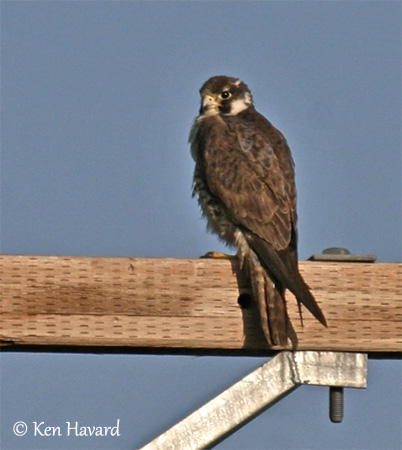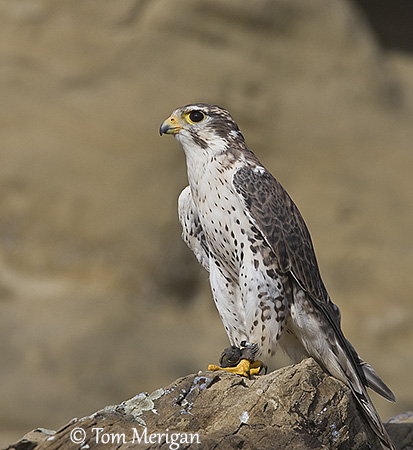
Fr: Faucon des prairies
Ang: Prairie Falcon
All: Präriefalke
Esp: Halcón Mexicano
Ita: Falco di prateria
Nd: Prairievalk
Sd: präriefalk
Photographers:
Tom Grey
Tom Grey's Bird Pictures
Ken Havard
My Bird Gallery & Flickr gallery 1 & Flickr gallery 2
Tom Merigan
Tom Merigan’s Photo Galleries
Text by Nicole Bouglouan
Sources:
HANDBOOK OF THE BIRDS OF THE WORLD Vol 2 by Josep del Hoyo-Andrew Elliot-Jordi Sargatal - Lynx Edicions - ISBN: 8487334156
BIRDS OF THE GREAT BASIN – by Fred A. Ryser, Jr - University of Nevada Press -ISBN: 0874170796
FIELD GUIDE TO THE BIRDS OF NORTH AMERICA - National Geographic Society - ISBN: 0792274512
HAWKS, EAGLES AND FALCONS OF NORTH AMERICA by Paul A. Johnsgard - Smithsonian Institution Press - ISBN: 1560989467
A GUIDE TO THE BIRDS OF MEXICO AND NORTHERN CENTRAL AMERICA by Steve N. G. Howell, Sophie Webb - Oxford University Press - ISBN: 0198540124
Animal Diversity Web (University of Michigan Museum of Zoology)
Sabino Canyon – Volunteer Naturalists
Bird Web (Seattle Audubon Society)
Arizona - Sonora – DESERT MUSEUM
Washington Department of Fish and Wildlife
South Dakota Birds and Birding – (Terry L. Sohl)
Wikipedia, the free encyclopaedia
Prairie Falcon
Falco mexicanus
Falconiformes Order – Falconidae Family
INTRODUCTION:
The Prairie Falcon is found in western North America, ranging from southern Canada to northern Mexico. The species is often resident or short-distance migrant, depending on food availability, especially in fall and winter.
It usually frequents open hills, plains, prairies and deserts, but it occurs mainly in fairly dry, open country, grassland and desert. It feeds primarily on small birds and mammals, but it also takes lizards and occasionally large insects.
The Prairie Falcon nests on cliff sides, above the shrubland in which it hunts. The species is monogamous, but mates do not stay together all year-round. Both adults share the nesting duties.
The Prairie Falcon has currently stable population, but some declines are reported in developed areas. The species is legally harvested for falconry in several states, affecting the local populations. But it is not globally threatened at the moment.

DESCRIPTION OF THE BIRD:
Biometrics:
Length: 37-47 cm
Wingspan: 90-113 cm
Weight: 420-1100 g
The Prairie Falcon is very similar to the Peregrine Falcon, but they are distinguished from each other by plumage colour.
The present species is a large, pale brown Falconidae with square head.
The plumage is warm grey-brown on the upperparts, with darker primary flight-feathers, whereas rump and tail are paler, especially on outer rectrices and tail tip.
The underparts are creamy white, barred or spotted dark in adults. On the barred black underwing, axillaries and underwing-coverts are black, except along the white leading edge. The undertail is white and barred black, but lower belly and vent are uniformly white.
On the square head, we can see a white supercilliary line above the eye, a narrow, black malar stripe on each cheek, a dark ear patch and a white area below the eye contrasting with both malar stripe and ear patch. Chin and throat are white.
The hooked bill is yellowish with yellow cere, brighter in male. The bill tip is blackish.
The eyes are dark brown, surrounded by bare, yellow eyering.
Legs and feet are yellow with black talons.
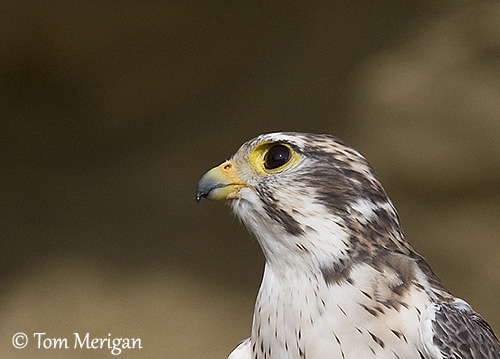
The female has similar appearance, but she has more heavily marked underwing coverts. She is slightly larger than male.
The juvenile resembles adult, but the white underparts are conspicuously streaked blackish.
On the head, the eyering is bluish, becoming yellowish in second year.
Both bill and cere are bluish, becoming gradually yellowish as the young bird enters second year, whereas the bluish bill tip becomes darker.
Legs and feet are bluish too, and become yellowish in second year.
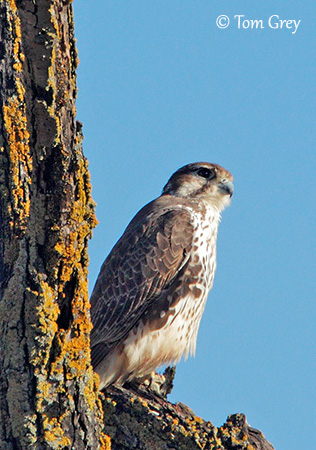
RANGE:
The Prairie Falcon is found throughout western United States, as well as parts of Mexico and Canada. The species is found in British Columbia, Alberta and Saskatchewan in Canada. In the United States, it occurs from N and S Dakota, S to Texas, Arizona and New Mexico. Sightings have been recorded in Manitoba, Minnesota, Illinois, Iowa and Indiana.
The Prairie Falcon is less migratory than other North American falcons. It is more a “wanderer” than a true “migrant”. It performs seasonal movements, depending on food availability. Most of them move north to east before heading south. Many birds return to winter near their breeding areas.
HABITAT:
The Prairie Falcon is adapted to arid landscapes. It nests on cliffs overlooking nearby open habitat where it forages for small mammals and birds.
It frequents open hills, prairies, plains and deserts, and occurs typically in dry open country. However, it can be seen in open areas above the treeline in high mountains.
During winter, it is mainly found in farmland and around lakes or reservoirs. It usually avoids forested regions and the species is rare on the coast.
CALLS AND SONGS: SOUNDS BY XENO-CANTO
The vocalizations of the Prairie Falcon are not well known. However, three types of calls are documented.
The territorial behaviour is accompanied by cacking calls, and the same calls are also used in alarm. It is described as a shrill yelping “kik-kik-kik”. This call is given when the adults confront an intruder on their breeding territory.
The female tends to produce harsher and deeper calls than the male.
During courtship and ledge displays, both mates give a typical “Eechup” also described as “chup” or “kuduchip”.
These calls are also heard during food transfers and aggressive interactions, but rarely during copulation.
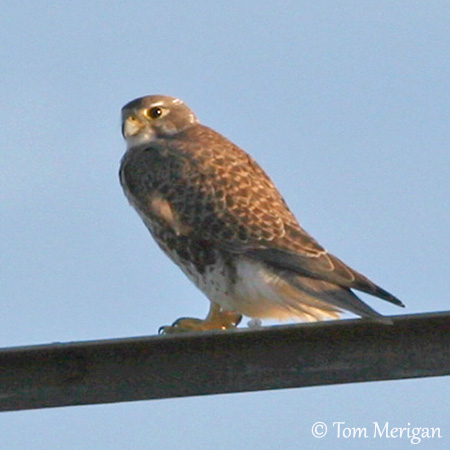
BEHAVIOUR IN THE WILD:
The Prairie Falcon preys mainly on small to medium-sized birds and small mammals. It prefers to attract the birds on the ground or when they have flushed and are just taking off.
The Prairie Falcon often hunts from perches, especially in winter. Once a prey is located, the bird performs a swift attack while flying close to the ground to avoid detection. The small prey may be snatched off the ground or caught in the air, but the larger prey are struck with the feet while passing. The toes are extended and the prey is seized and dispatched in the powerful talons, rimmed grip, which are able to crush the skull of a mammal.
When the prey is a bird, the Prairie Falcon bites through the neck vertebrae, severing its backbone.
Then, the headless prey is brought back to the nest. The birds are plucked whereas the mammals and lizards are skinned before to be given, piece by piece, to the chicks.
The favourite prey items are ground squirrels, Horned Lark, Western Meadowlarks, Mourning Dove, Brown-capped Rosy-Finch and blackbirds (Icteridae). It also takes reptiles and large insects.
The Prairie Falcon is monogamous during the breeding season. The pair is usually established when the birds arrive at their breeding grounds.
Male and female may spend a month visiting potential nest-sites, and the courtship displays include much flying about and calling near the cliff ledges. However, an experienced pair often returns to its nest-site of the previous year.
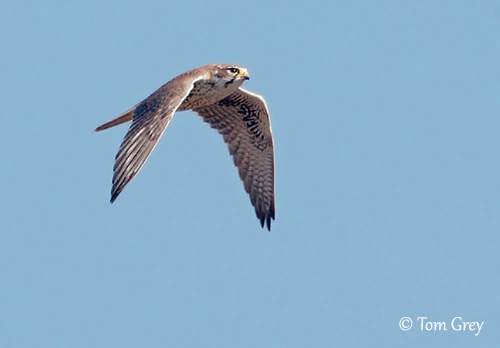
The displays include ledge displays, with the male performing aerial acrobatics, struts back and forth at nest-site. They also perform head-low bows and mutual soaring, often accompanied by vocalizations. In order to attract the female to the ledges, the male uses food and typical “Eechup” sounds.
The copulation begins almost two months before the clutch is completed, and it lasts about ten seconds. Concerning the nesting duties, the female assumes them while the male is hunting for her, and then, for the whole family.
The nest-site is usually on cliff-ledge, protected by overhanging rocks. This type of location is inaccessible to mammalian predators, placed about 10-11 metres above the cliff base.
The Prairie Falcon is found in pairs only during the breeding season. The territory is strongly defended, as indicated by several observations of numerous aggressive interactions between pairs.
From several observations, the Prairie Falcon is also known for its “vile and unpredictable temper” after being disturbed at nest by human observers. Other bird species such as Common Raven, Barn Owl and Great Horned Owl flying near disturbed Prairie Falcons are often attacked and may be stunned or killed.
An observation describes a pair of Barn Owls flushing from the same cliff were killed by falcons. In a single pass, the male falcon killed one of the owls, while the female falcon stunned the other.
The Prairie Falcons are quick to challenge other Birds of Prey which enter the territory around the nest-site, but they usually just harass them and occasionally strike them.
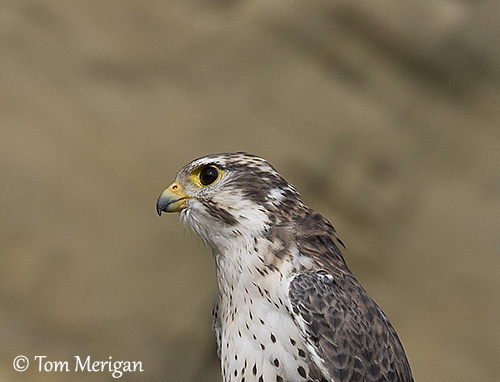
The Prairie Falcon may be a permanent resident near the nesting sites. But others move short-distances southwards to spend the winter or eastwards towards the Great Plains after the nesting season. Their movements also depend on food availability.
It performs a rapid and direct flight with moderately fast, shallow wingbeats. The flapping flight is performed with short, rapid strokes, more downwards than upwards.
It glides with the wings held flat or slightly below body-level, and the wingtips are curled up. It is able to soar 4 to 5 times longer distances by flattering the wings and fanning the tail.
While hunting, it flies fast and low over the ground. But it also dives steeply from the air, or pursues the birds in flight. It is probably just as fast as Peregrine Falcon, but it does not dive from high altitude to catch or pursue a prey.
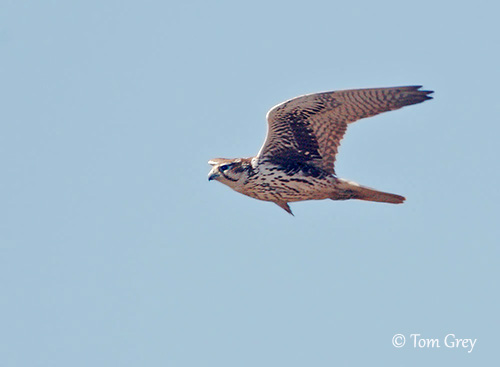
REPRODUCTION OF THIS SPECIES:
The Prairie Falcon usually breeds when two years old. It establishes the nesting territory from late February through March in most part of the breeding range. The breeding season takes place from February to July, with a peak from April to May.
The Prairie Falcon does not build a nest, but it uses a scraped depression in gravel or dirt on cliff ledge with overhanging rocks protecting the nest-site.
However, it may sometimes nest on dirt bank, or it uses an abandoned nest of raven if it is placed on a ledge. It rarely nests in tree, but it may occasionally use abandoned stick nest built by the Golden Eagle or hawks.
The female lays 3-5, sometimes 2-6 whitish eggs with brown markings. The incubation is mostly by female and lasts about 27 to 31 days. She is fed by the male during this period, and it may sit on the eggs while she is feeding.
The female remains with the young during the first four weeks. The male continues to bring food and she feeds the chicks. Following this period, the female begins to do some hunting. The young leave the nest 5-6 weeks after hatching. They become independent a little more than two months after hatching. They are sexually mature within two years.
Nestlings and eggs are affected by predation. Numerous nests on cliff ledges are not accessible by mammalian predators such as coyotes and bobcats. But the Birds of Prey including the Great Horned Owl and the Golden Eagle, prey both on adults and nestlings.
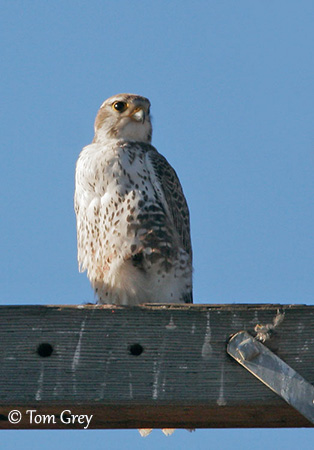
PROTECTION / THREATS / STATUS:
The Prairie Falcons are numerous and widespread, and the population appeared to be stable between 1966 and 2014.
The species has been affected by the use of DDT in the mid-20th century, causing eggshell thinning and numerous nest failures.
It is also affected by habitat degradation caused by conversion of grassland for agriculture expansion. On the other hand, agriculture development offers water and ground cover for ground squirrels which are often preyed upon by the Prairie Falcon.
Illegal shooting is still a common cause of mortality.
Other factors such as wildfires affecting ground squirrel populations, mining development destroying nest-sites and human disturbances in nesting areas have also a negative impact.
And the Prairie Falcon is legally harvested for falconry in several states, affecting the local populations. Most harvested birds are taken as nestlings.
Following these problems, the population is slowly declining in North America, but the species is not considered globally threatened at the moment.
The Prairie Falcon is currently evaluated as Least Concern.
